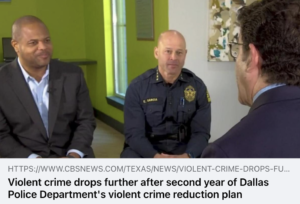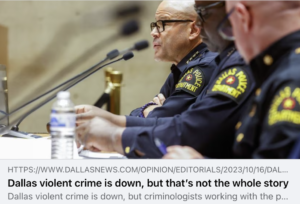
Copied from Nov. 19, 2023 email to Dallas Citizens from Mayor Eric Johnson
Dallas is becoming a safer city. There is no question about that.
In 2021 and 2022, every major category of violent crime declined in Dallas compared to the previous year. No other top 10 city in America can say that. While you’re never truly happy until violent crime is at zero, this is nonetheless a remarkable accomplishment.
This year, overall violent crime is trending down again — significantly. Percentage-wise, Dallas is on pace for a double-digit decrease. This means fewer victims of violence in this city than the year before, which is fantastic.
But the work isn’t done. Not by a long shot.
So with 2023 winding down, it’s time to take stock of what Dallas did well this year — and where this city must step it up in 2024.
Straight Talk
This year, my goal was for Dallas to do the seemingly impossible: to achieve three consecutive years of lowering every form of violent crime.
The violent crime stats so far this year are very good overall. The city is tracking at about 1,000 fewer aggravated assaults to date and nearly 140 fewer robberies. Simple assaults are also down, and so are sexual assaults.
But one category will likely prevent Dallas from reaching my goal for 2023: Murders are likely going to be up this year over 2022’s total.
That’s never something you want to see. These numbers represent people’s lives, and it’s always tragic when any lives are lost to violence in this city. And to be very clear and perfectly frank, I am very unhappy about this increase. Very. It’s simply not something that anyone in any leadership position in this city can or should accept. Period.
The Plan
Looking ahead to 2024, Dallas must continue to be strategic about its approach.
Murders are the rarest of all the major violent crimes. Some murders are crimes of passion. Often, they are the result of unchecked escalating violence — domestic assaults, robberies, gang retaliations, or drug turf wars. Simple assaults can become aggravated assaults when a fistfight turns into a gunfight. And an aggravated assault can easily become a murder if a bullet’s trajectory shifts by only a few inches.
That’s why it’s so important to focus heavily on continuing to reduce aggravated assaults, robberies, rapes, family violence attacks, and other acts of violence. Breaking cycles of violence can save lives. This is what the police department has been prioritizing in recent years through its violent crime reduction plan and its domestic violence reduction plan.
The police chief and his team deserve a great deal of credit for working with criminologists to develop and refine these plans, which have been remarkably successful over the past three years, even in light of this year’s projected increase in murders over last year.
The men and women of the Dallas Police Department also deserve credit, praise, and gratitude for implementing these plans every morning, every afternoon, every evening, and every night. It’s a tough job, and this city has high standards. But they do it — and they do it well.
The community has also stepped up in a major way these last few years. People in this city have helped keep kids out of trouble. They work with the police department, with the schools, with city departments, with community organizations, and with each other to ensure that crime is reported and that criminals are caught.
This year, the Dallas Police Department is getting the funding it needs from the city’s budget and is working to hire more officers. More officers are sorely needed. Meanwhile, the officers who are working the streets today are continuing to implement the chief’s strategies, including hot-spot policing through micro-grid targeting, place-network investigations, focused deterrence that builds community relationships, and operations to stop gangs and narcotics activities. And Neighborhood Patrol Officers are working with crime watch groups and organizations to ensure that everyone is part of the solution.
That’s all very good. But Dallas still must intensify its efforts to reduce violence. Police recruiting and hiring must improve. Community engagement must increase even more. Non-policing solutions, such as improving lighting in high-crime areas, must be supported. It’s also critical for the entire criminal justice system — judges, prosecutors, and juries — to deal with violent offenders appropriately. Once Dallas police officers stop criminals, the jail cannot have a revolving door. Repeat offenders must be held accountable and brought to justice.
The “kitchen-sink” approach has made Dallas stand out nationally for its successes over the past three years. But this approach could always use some refreshing. After all, criminals adapt. We must, too.
Fight On
I remain very optimistic about where this city is headed.
Dallas is a dynamic, growing city that is becoming stronger and more vibrant. Business is booming. Jobs, people, and major corporations are moving here in droves. Exciting new entertainment options and restaurants are opening all the time. Blight is making way for new development. And the next bond package should include significant improvements of parks and recreational activities, which will attract and retain families.
This is a long game, and Dallas is winning. But there is still more progress that needs to be made.
Murders need to drop again next year as they have in the previous two years. And the fight for an even safer city — the fight to save lives — needs to continue.
Dallas cannot become complacent. Public safety must always come first. An attitude of “good enough” will never be good enough for the people of Dallas or its mayor. This administration won’t accept anything less than the relentless pursuit of excellence from your city government.
Now, have a great Thanksgiving week with your families! Take care, and stay safe.



